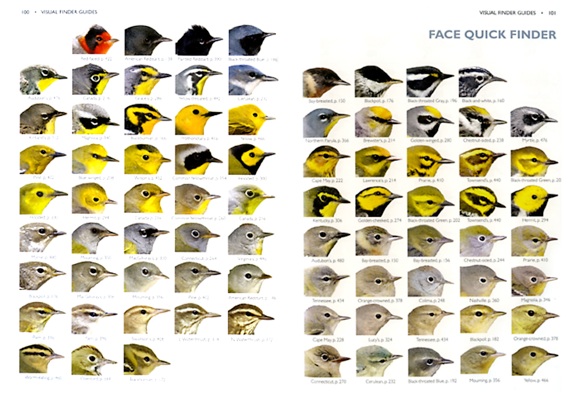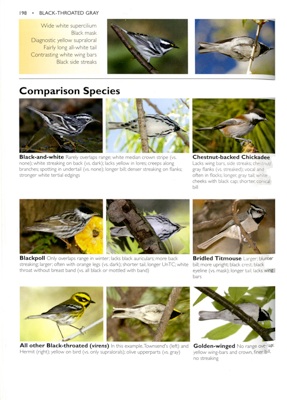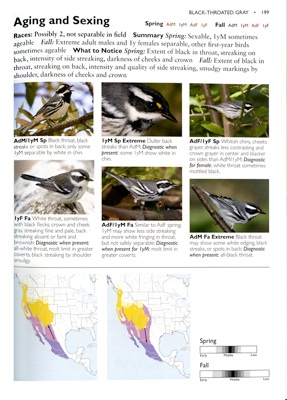A practical guide to bird watching in Sonoma County, California
(Unless otherwise indicated, all phone numbers are in the 707 area code)
A practical guide to bird watching in Sonoma County, California
(Unless otherwise indicated, all phone numbers are in the 707 area code)


general FIELD GUIDE REVIEWS
© Colin Talcroft, 2009, 2010, 2011, 2012, 2013, 2014, 2015
Unless noted, all photos by the author. If you would like to use one of my images, please ask for permission for non-commercial use with proper credit or commercial use with proper compensation.
BOOK REVIEW
The Warbler Guide

Weighing in at nearly three pounds (2 pounds, 13 ounces, or 1,276g) and at 6.25 by 8.75 inches, this is not a book that will lend itself to convenient field use. It’s more likely to be kept in the car for reference or studied at home--but it promises to be fun and rewarding. Having said that, I suspect it will take some getting used to for many readers. The presentation is novel and it will be unfamiliar to most, although authors Stephenson and Whittle have been introducing the techniques recommended in The Warbler Guide for some time now (hosting workshops and giving lectures around the country to introduce their ideas). It may be helpful to look at the Princeton University Press blog, which presents a series of videos on how to use the book’s features (The Warbler Guide). It’s for good reason that the first species account (American Redstart) doesn’t start until page 138; the first 137 pages are a very complete explanation of how to use the book and the new approach the authors advocate.
The Warbler Guide
By Tom Stephenson and Scott Whittle
Princeton University Press, 2013
Flexibound, 560 pages
Retail price: $29.95
Recommended
It’s useful to look at the organization of the material in some detail, as the organization is itself an expression of what the authors believe is important about warbler ID. The book begins with a quick introduction to its principal sections. Of particular note is a paragraph explaining why the species are presented in alphabetical rather than taxonomical order: the authors argue that alphabetic ordering eliminates potential confusion resulting from ongoing uncertainty about warbler taxonomy and rapidly changing views about warbler relationships that can lead to quite different taxonomical layouts in different sources. The species accounts are headed with icons designed to convey pertinent information quickly. A section explaining the icons and key terms used in the text comes next, followed by a section on using the range and migration maps in the book. Following that is a guide to warbler feather topography that spans four pages.
The material between page 100 and the first species account, on page 138, is a group of “finders.” There is a “Face Quick Finder” that presents a face thumbnail for each of the species covered, with the page number for the relevant species account given below each thumbnail; a “Side Quick Finder,” a similar table of side views for each species; a “45-degree Quick Finder;” an “Underview Quick Finder;” and three more of these quick finders arranged by geographical range and season--one for Eastern spring warblers, one for Eastern fall warblers, and one for primarily Western warblers. There is a table of “Eastern Undertails” and of “Western Undertails,” and finally another 20 pages or so containing more “finders,” these relating to vocalizations, including: “song finder charts” (categorized with words such as “buzzy,” “trilled,” “complex,” and “clear;” a “chip call finder;” and a “flight call finder.” All of these are designed to allow the user to quickly make an initial guess about an unknown bird based on available information--whether that information is a glimpse of a bird’s belly and tail or a snippet of song.

Icons at the top of a species entry; icons give quick general information about silhouette, basic color pattern, undertail pattern, geographical distribution, and typical environment--in this case, the icon indicates that Black-throated Gray Warbler usually exploits the mid-canopy.
The meat of the introductory material, however, is a nearly forty-page essay called “What to Notice on a Warbler” divided into sections headed: Contrast and Color; Size Shape, Habitat, and Behavior; The Face; The Body; and The Undertail. Next is a short section on methods of aging and sexing warblers, followed by three substantial sections devoted to sonograms and warbler song. The book makes extensive use of sonograms and suggests careful study of these is among the best ways to learn and remember warbler songs--and to identify warblers. The three, detailed song-related sections are “Understanding Sonograms (six pages), “How to Listen to Warbler Songs” (20 pages), and “Learning Chip and Flight Calls” (an additional 10 pages).
That leaves us at page 100.
The Face Quick Finder
The species accounts--the core of the book--show each bird from various angles (usually three), treating male and females as separate “species” when plumage differences are significant. Bright and drab variants get separate “species” entries as well--MacGillivray’s, Magnolia, and Mourning Warbler, for example, all have separate bright and drab entries. These main photographic views are supplemented with “distinctive views” that highlight important field marks, and followed by “additional photos” that underscore other important points visually. Immediately following these we find photos of “comparison species”--species likely to be confused with the bird in the main entry. These comparison species photos are critical to the approach--and more about that later. The comparison photos are followed by information on aging and sexing each species (again with many photographs), by range maps showing migration routes (including graphs indicating peak spring and fall migration period), and then by sonograms for each species--and, importantly, sonograms for all the comparison species as well.

Sonograms in the Black-throated Gray Warbler entry: Sonograms of Black-throated Gray vocalizations appear on the left page. Species suggested as birds with vocalizations similar to Black-throated Gray appear on the facing page.

At the very end of the book (following the species accounts) is a section on non-warbler species that may be confused with warblers--birds such as kinglets, verdins, gnatcatchers, chickadees, vireos, and certain sparrows are touched upon. Yellow-breasted Chat and Olive Warbler are relegated to the back of the book on the assumption that neither is a true warbler. They are given the same treatment as the true warblers, however, although with less detail. There is a note on hybrid warblers and then a substantial Quiz and Review section that presents photos of problematic individuals with date and location information that allow the reader to test the book’s method.
The end material consists of a three-page chart of warblers in flight; a chart showing North American warbler taxonomy (Olive Warbler and Yellow-breasted Chat are omitted); a table of warbler measurements (length, wingspan, and weight); a table of silhouettes; a table summarizing habitat and behavior characteristics; a glossary; a list of additional resources (books, audio, research papers, web resources, birding festivals, apps, and others); acknowledgments; photo credits; and an index. The front and back endpapers are blank. Fold-out flaps on the front and back covers can be used as place holders. The front flap is printed with a map legend, a key to the sonograms, and a short list of frequently used abbreviations. The back flap is printed with information about the authors.
A new approach. So, what is that approach? As may be apparent from the above detailing of the book’s content, Stephenson and Whittle work on the assumption that birders in the field are usually trying to identify warblers based on fleeting or partial visual clues or on vocalizations. This seems a very logical assumption. Probably all birders looking at warblers have had the experience of trying to identify a bird mostly hidden by vegetation or after a brief look at only part of a bird. The Warbler Guide offers its “quick finders” as a starting point for identification. The first step is to choose a suspect species based on visual (or aural) impression. The authors declare that it should be possible to quickly identify any unknown warbler even if the initial guess is incorrect because every entry is accompanied by photos of comparison species--those birds most likely to be the correct bird if the first bird chosen is not. In other words, after forming an initial impression, the user heads for the finders to select a best-guess candidate that then becomes a hub around which similar and likely other species information is arranged. The sonograms are presented the same way--sonograms for the main species are followed by sonograms for the comparison species. Once you see the logic, you begin to appreciate the way the species accounts present a wealth of pertinent information economically.
I have to admit I found the book daunting when I first picked it up; the large amount of introductory material is intimidating and it’s likely to require careful study to be optimally useful (and I suspect many readers will find the sonogram data too abstract and challenging to bother with--an accompanying CD would have been useful here), but the more I look through The Warbler Guide, the more I’m beginning to see the attraction of presenting ID information using this “hub and spokes” approach. I find myself looking forward to autumn migration for a chance to try the book out with real-life problems. I plan to come back to this review after putting the Stephenson and Whittle approach to practical application, but, so far, I’m inclined to say The Warbler Guide is likely to be a useful, satisfying--and entertaining--purchase for any serious birder interested in warbler identification. Recommended.
A mobile app version of The Warbler Guide is now available as well, recently updated (January 2015).


A main species entry showing side view, 45-degree view, and undertail view on left page. Right page shows
“distinctive views” and additional photos designed to highlight salient features


A main species entry continued, showing comparison species, information about aging and sexing the main entry species, and range maps
with migration routes and graphs that indicate the timing of the peak spring and fall migration of the main species
